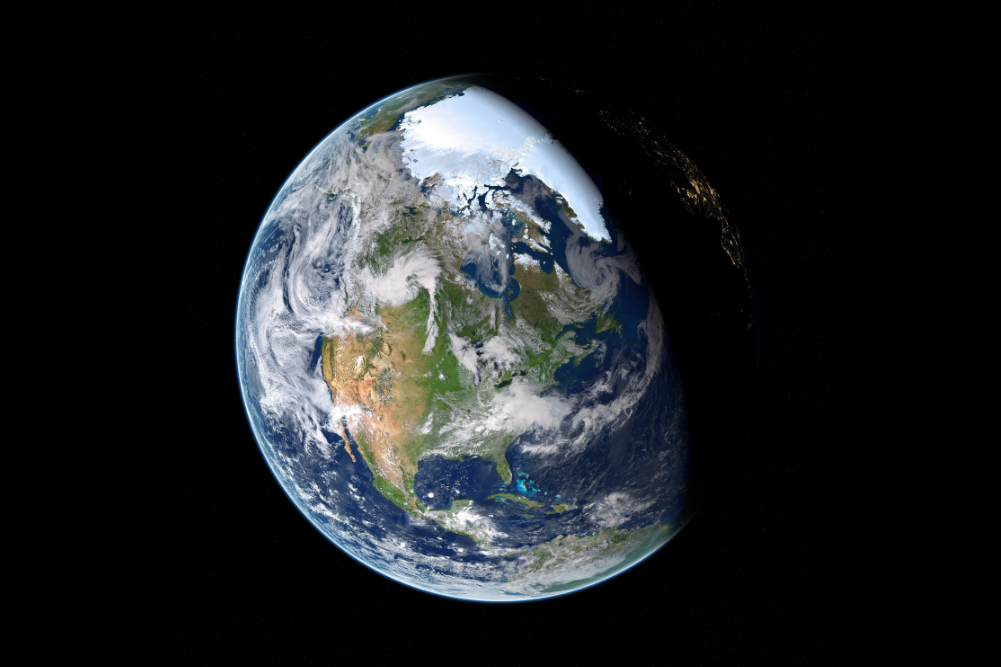Green living for the ozone
Following a peak of awareness in the early 1990s, when it was championed by then US Vice-President Al Gore, the environmental issue of ozone depletion has largely disappeared from the public consciousness and the media. Nevertheless, Many of the important steps involve choosing natural hydrocarbon refrigerants where they are available.
The basics
When certain ozone-destroying substances (known as ODS) are released into the air in gaseous form, air currents may eventually carry them up to the stratosphere (a layer 10-30km above the earth’s surface). The molecules of these chemicals are broken apart by strong ultraviolet light to release chlorine or bromine atoms, which in turn destroy ozone (O3) molecules. It has been estimated that a single chlorine atom in the stratosphere can destroy an estimated 100,000 molecules of ozone. Nature has its own process of ozone production and destruction, but ozone creation reactions have been unable to keep up with the recent rate of loss.
Complex and not yet fully understood interactions take place between ozone depletion and global warming; however, it is broadly agreed that the warming of the earth’s lower atmosphere, in turn, leads to a cooling of the upper stratosphere. These lower temperatures result in a reduction in the rate of ozone formation. Some ODS, including chlorofluorocarbons (CFCs), and some ozone-safe alternatives are powerful greenhouse gases. As is often the case, a high level of consumer discernment is a valuable asset.
The alarm about ozone depletion was raised in 1974 when scientist James Lovelock detected CFCs in the atmosphere all around the world, but no substantial international action was taken until 1984, when conclusive evidence of stratospheric ozone loss had been produced. This culminated in 1987 in the signing of the Montreal Protocol by many countries.
One function of the ozone layer is to filter out harmful UV-B ultraviolet radiation from the sun; ozone’s ability to absorb this type of radiation has been shown in laboratory experiments. Separate research has shown that for every one per cent drop in ozone, one to two per cent more UV-B will reach the earth’s surface; in Antarctica a clear correlation between reduced ozone levels and higher UV-B levels has been found.
Exposure to UV-B can cause DNA damage in humans, animals and other living things including food crops. In people it has been linked to increased incidence of eye cataracts and skin cancers. Marine life is particularly vulnerable to UV-B, which affects the growth, photosynthesis, protein and pigment content of phytoplankton, thus destabilising the marine food chain. It is likely to reduce the yield and growth of plants and it will even shorten the lifetime of materials such as plastics, rubber, wood, paper and cotton.
The thinning of the ozone layer is monitored by a measurement system called the Total Ozone Mapping Spectrometer (TOMS). Depletion is so marked over Antarctica that the term "ozone hole" is now used, and there is significant ozone loss at all latitudes outside the tropics. Southern hemisphere exposure to the sun becomes more of a risk the further south you travel, and around mid October last year TOMS showed the hole had extended to populated areas near the tip of South America.
It’s important not to confuse the ozone layer with ground-level ozone, produced by sources such as car exhausts and photocopiers. This manmade ozone is a noxious pollutant which reacts with sunlight to produce photochemical smog. There is a limited number of known manmade ODS, including:
- Chlorofluorocarbons (CFCs). May be used as a refrigerant, aerosol propellant, in industrial cleaners and fire extinguishers; for dry cleaning and the manufacture of electronics, styrofoam, polyurethane blow-in insulation and foam boards (polystyrene, polyurethane, polyethylene, isocynanurate and phenolic).
- Hydrochlorofluorocarbons (HCFCs). Used as a refrigerant, in the manufacture of electronics, and production of foam boards and styrofoam.
- Bromofluorocarbons (BFCs) also known as halons. Used in fire extinguishers.
- Hydrobromofluorocarbons (HBFCs). Used in fire extinguishers.
- Carbon tetrachloride, also known as tetrachloromethane. Used as a feedstock in the manufacture of CFCs.
- Bromochloromethane. A toxic, relatively new chemical used until recently in fire extinguishers.
- Methyl bromide, also known as bromomethane. A toxic chemical used as a soil pesticide and as a fumigant in quarantine and pre-shipment.
- 1,1,1 trichloroethane, also known as methyl chloroform. May be used in liquid paper (Tippex), and as an industrial solvent.
All these chemicals are subject to a global phase-out (with certain exemptions) and in some cases they are being used in developing countries but not in developed countries.
The Montreal protocol
This international agreement and its later amendments have been signed by nearly all the world’s countries, providing a framework for the progressive phase-out of ODS. The highest priority was an international phase-out of CFCs, the class of chemicals of the greatest concern at the time. The initial Protocol required parties to make 50 per cent cuts from 1986 levels of the five main CFCs; the production and consumption of the three main halons were also required to be frozen at 1986 levels from 1993 onwards. By the end of 1995 all developed countries had phased out both CFCs and halons, while developing countries will have until 2010 to stop using CFCs and most halons.
The 1990 London Amendment added methyl chloroform (1995 phase-out for developed countries/2015 developing countries), carbon tetrachloride (1995/2010) and a further range of CFCs to the schedules. The 1992 Copenhagen Amendment established a schedule for the phase-out of HCFCs (2030/2040), HBFCs (1995/1995) and methyl bromide (2005/2015), and in Beijing in 1999 bromochloromethane (2002/2002) was added, too. Another outcome of the Copenhagen Amendment was the creation of what is known as the Multilateral Fund, to be financed by developed countries and administered by the World Bank, which would serve as the route for financial and technology transfer to developing countries for switching across to ozone-friendly alternatives.
Under the terms of the Protocol, developed countries are prohibited from importing ODS, and products containing them, from developing countries. The 1997 Montreal Amendment created a system of import/export licences for ODS, mainly to tackle a growing illegal trade in these chemicals. Internationally, the Protocol is administered by the Ozone Secretariat, a part of the United Nations Environment Program (UNEP) based in Nairobi, Kenya. September 16 was recently proclaimed by the UN the International Day for the Preservation of the Ozone Layer.
Exemptions
Exemptions to the agreement centre around what are regarded as essential uses, examples being CFCs in asthma inhalers, methyl bromide for quarantine and pre-shipment, and halons in fire extinguishers for use in military aircraft.
Scientists have recently begun to raise some concerns about four chemicals not covered under the Protocol. One of these is halon 1202, which was exempted because at the time its total use was minimal. However, in recent years atmospheric concentrations have been increasing annually by 17 per cent and there has been a five-fold increase since the late 1970s. The CSIRO has called for this chemical to be added to the Protocol. The vast majority of emissions are suspected to be coming from China, where it is used as a feedstock for the production of halon 1211, a chemical that does come under the Protocol.
Three newer chemicals with the potential to damage the ozone layer are:
- Hexachlorobutadiene (a solvent, also the byproduct of the production of chlorinated chemicals such as vinyl chloride)
- N-propyl bromide (which is being aggressively marketed as an industrial solvent, and a feedstock for pharmaceutical and other industries)
- 6-bromo-2-methoxyl-napthalene (used in the manufacture of methyl bromide) In each case, more research is needed before reaching any conclusion, but it may be important that some are these are covered under future amendments.
Methyl bromide
Methyl bromide is a highly toxic, colourless and odourless gas used as a soil pesticide and as a fumigant in quarantine and pre-shipment. The US EPA estimates that if it were not subject to a phase-out the pesticide use of the chemical would account for 5-15 per cent of future ozone depletion. Friends of the Earth in the US claims that methyl bromide initially has 10 times the ozone-depleting potential (ODP) of CFC-11 and that its ODP exceeds that of CFC-11 for a time interval of between 20 and 30 years.
Toxicity issues have led many countries to switch to alternatives, and it has been banned in the Netherlands and Scandinavia. Compared with other ODS, alternatives to methyl bromide have been less readily available but the Pesticide Action Network North America believes many other safe and environmentally sustainable options now exist.
Australia is currently using methyl bromide as a soil pesticide for crops including apples, strawberries, melons, capsicums, tomatoes and flowers, and as a fumigant. In recent years there has been a steep rise in methyl bromide usage for quarantine and pre-shipment by developed countries, potentially alarming given this is exempted from the 2005 phase-out (see Actions, number 11).
Politics
Hydrofluorocarbons (HFCs) are a class of chemicals widely used as an ozone-safe alternative for refrigeration, fire extinguishers, specialised aerosols, solvents and foam-blowing. Unfortunately, they have the drawback of a high global warming potential (GWP) and have drawn strong criticism from Greenpeace and other environment groups; R134a, the most commonly-used HFC, has a GWP 1300 times greater that of carbon dioxide. Denmark aims to ban them by 2006, and they are being phased out in Austria, Luxembourg, Sweden and Switzerland.
A 2000 Burnbank Consulting report, which looks in detail at ODS and HFCs in Australia, anticipates a steep 480 per cent increase in our HFC emissions between 2000 and 2020. From a greenhouse perspective, hydrofluorocarbons and related chemicals are attracting increasing global attention. An informal lobby group seeking the introduction of more benign alternatives to fluorocarbons is MIPIGGS (Multisectoral Initiative on Potent Industrial Greenhouse Gases).
Meanwhile, fluorocarbons are being vigorously promoted and defended by powerful industry lobby groups which are drawing attention to the ozone-safe status of HFCs but not the GWP. The US-based Alliance for Responsible Atmospheric Policy, which champions the use of HCFCs and HFCs, has numerous manufacturers and industry bodies as members.
In 1992, Greenpeace teamed up with an East German appliance manufacturer to produce the hydrocarbon-based Greenfreeze fridge. This uses propane and isobutane as environmentally preferable refrigerants, and cyclopentane for blowing the polyurethane insulation foam. All large European fridge manufacturers have since switched over to cyclopentane for foam-blowing. This technology has proved to be a great success and hydrocarbon fridges are now on sale in several European countries as well as Brazil, China, Cuba, India, Indonesia, Japan, Sri Lanka and Turkey. While they are being marketed by all major European appliance companies, hydrocarbon refrigerants are banned in the US for nearly all uses, ostensibly due to flammability concerns.
In a major 2000 campaign, Greenpeace successfully persuaded Coca-Cola to adopt Greenfreeze technology for the Sydney Olympics; this move has since been replicated in the company’s operations worldwide. A number of other international companies are now phasing out HFC refrigeration equipment in favour of hydrocarbons.
Environmentally sound cooling alternatives for hot climates include avoiding the use of home air-conditioning through improved building design, shading or heat-reflecting paint. Parked cars can be kept cool by a windscreen shade or trees. Foam products can be blown using water, carbon dioxide and hydrocarbons such as pentane instead of HCFCs. Other options for fire extinguishing agents include carbon dioxide, water, foam and dry powder. Around the world, environmentally conscious cities have been taking the lead in demanding ozone-safe alternatives. In Spring 1999, Vienna brought in a ban on construction materials produced using ODS.
Hydrocarbons
The Blue Mountains-based Greenchill Technology Association represents Australian hydrocarbon refrigerant manufacturers including Elgas, Hychill and Origin Energy. While hydrocarbons are greenhouse gases, their GWP is far lower than that of HFCs. Greenchill sees hydrocarbon technology as having the added benefit of being more energy-efficient. Currently two imported brands of hydrocarbon fridges — Vestfrost and Liebherr — are available in Australia. Some models in both ranges are highly energy-efficient, receiving a 5<\#189>- or 6-star energy rating under the Australian Standard. In both cases, the polyurethane is blown using cyclopentane.
Motor vehicle air-conditioning systems represent about half of all refrigerant use in Australia. Hydrocarbon refrigerants can legally be used in vehicle air-conditioning aftermarket in Victoria, WA and SA, where their market share is rapidly increasing. In other states, hydrocarbon refills of vehicle systems are either banned or have an uncertain status (as is the case in Tasmania and the ACT at the time of writing). As hydrocarbons are flammable, certain safety precautions need to be taken when working with them.
At present it appears that no domestic air-conditioning unit on sale in Australia uses hydrocarbon technology; instead the HCFC R22 is the most common choice. For domestic units, the aftermarket use of hydrocarbons is allowed in all states, but there is currently little use due to resistance to change. In October 2002, the Commonwealth Ozone Protection Act is due to go to parliament. It involves two major reforms: the extension of regulatory end-use controls to include HFCs as a result of their high GWP, and the transfer of regulatory controls for these and ODS from the states to the commonwealth under a new national regulatory framework. However, in its present form, the Act does not particularly encourage a transition to hydrocarbons and there is scope to lobby for this.
Ultimately, however, responsibility rests with individuals, companies, groups and government bodies as they make purchasing decisions; hopefully, future choices will be both well considered and well informed.
Take action
Vehicle air-conditioners
- If buying a new vehicle with air-conditioning, avoid models using an HCFC (R22, R141b) refrigerant and give extra preference any that use a hydrocarbon.
- Keep well maintained to minimise the risk of gases escaping.
- Look into the possibility of converting the vehicle to a substitute refrigerant. If in Victoria, WA or SA, try to ensure that the replacement refrigerant is a hydrocarbon.
Domestic air-conditioners
- If buying a new air-conditioning system or heat pump, avoid models using an HCFC refrigerant. Consider waiting until a hydrocarbon model comes on the market.
- Keep well maintained to save a substantial amount of energy and to minimise the risk of gases escaping.
- If buying a new fridge, go for a Vestfrost or Liebherr model. Otherwise, avoid models using HCFCs as either the refrigerant or the foam-blowing agent.*
- Continued possession of a yellow (BCF) fire extinguisher attracts a fine. These contain halons and can be handed in to most fire brigades or fire equipment suppliers.
- Avoid styrofoam cups and packaging, including items labelled as "CFC-free", unless the company has confirmed it does not use an HCFC as the blowing agent.
- Before buying foam boarding, ask whether an HCFC is being used to blow the product.
- Before buying electronic equipment, ask whether an HCFC is being used to spray the circuit boards.
- Ensure that the apples, strawberries, melons, capsicums and tomatoes you buy are certified organic. Think twice about buying flowers.
- Ask your local council to draft an ethical procurement policy that ensures all the following items do not contain and have not been manufactured using HCFCs: refrigeration equipment, air-conditioners, heat pumps, vehicle air-conditioners, styrofoam cups, electronics, foam boards, polyurethane blow-in insulation.
- If you live in NSW or Queensland, write to your minister for industrial relations, asking for the legalisation of hydrocarbon refrigerants in the vehicle air-conditioning aftermarket. Further details regarding NSW are at www.greenchill.org/repeal. Research released last year by Peter Kjeldsen of the Technical University of Denmark shows that shredded foam from junked refrigerators can release significant amounts of CFCs.
- Write to relevant MPs: Requesting that the Ozone Protection Act reforms require the safe disposal of this foam before refrigerators are scrapped; Calling for a swift transition to natural refrigerants to be provided for in the Ozone Protection Act reforms; and asking that the Act includes a framework for the rapid transition to ozone-safe methyl bromide alternatives in the area of quarantine and pre-shipment, which do not encourage food irradiation.
Internet resources
- www.unep.ch/ozone
- www.unep.ch/ozone/pdf/ozone-action-en.pdf
- www.uneptie.org/ozonaction
- www.ea.gov.au/atmosphere/ozone
Martin Oliver is an activist, writer and researcher based in northern NSW. He can be contacted at moliver@planet-save.com







